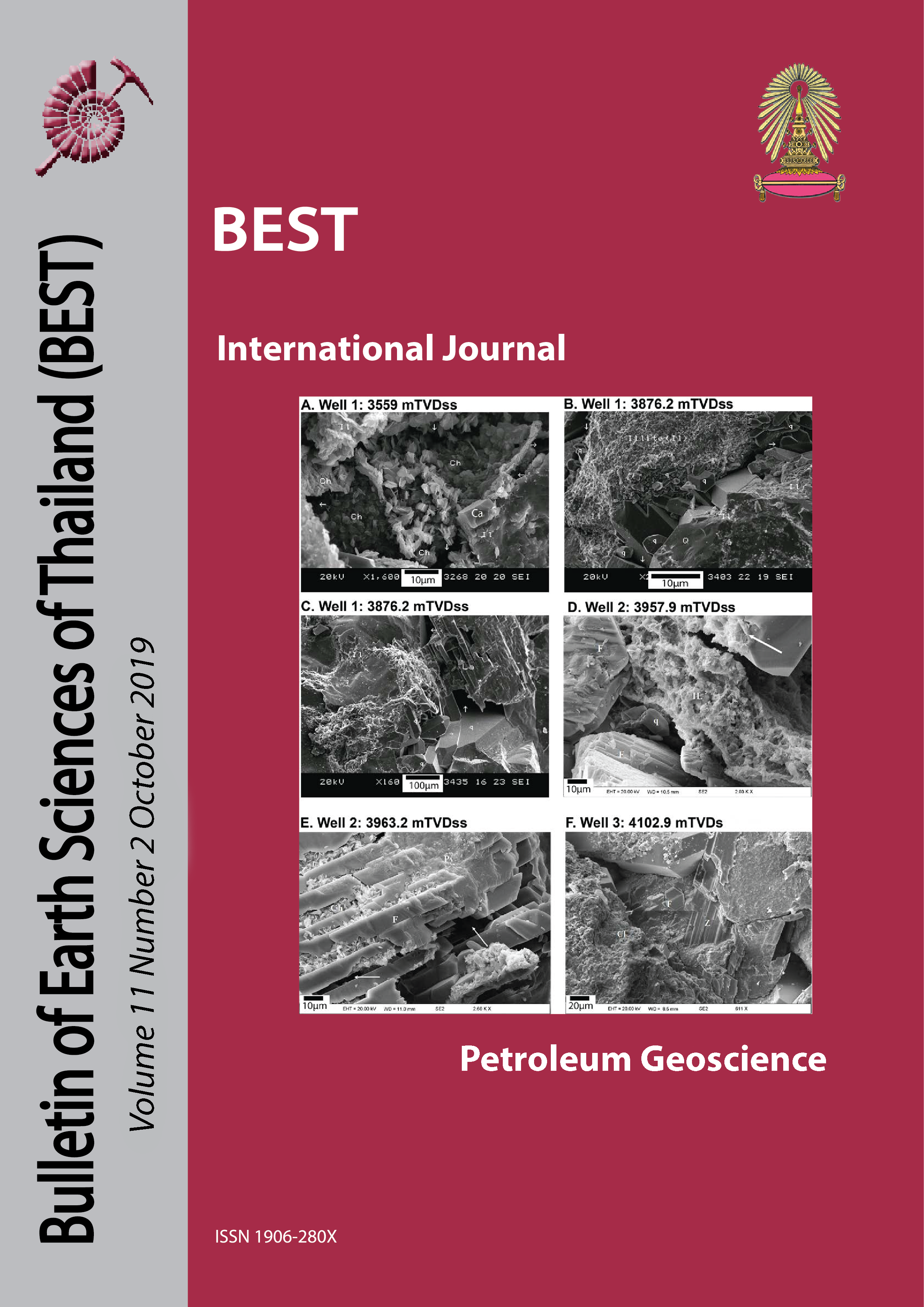Structural geology related with fracture development and fluid evolution at Khao Tham Phedan, Nakhon Sawan Province, Central Thailand
Main Article Content
Abstract
Owing to the complexity of structural geology and diagenetic history across Permian carbonates at western margin of Indochina block in Nakhon Sawan province, in the northern part of Central Thailand, there are still many poorly understood aspects. The overprint from several tectonic stages and multiphase fluid crossflows, means an integration of the study of structural evolution and characterisitc of isotopic signatures is required to better understanding the carbonate diagenetic and tectonic history across the region. The study area preserves two structural styles, less and more intensely deformed zone along with two main fracture orientations, NE-SW and NNE-SSW. Carbonates textures show the rocks responed to deformation by forming cross-cutting veins, reactivated fractures, fractures exposed to multiple phases of fluid flow, and an abundance of microfractures in matrix portions of the rocks.
Using stable carbon-oxygen isotope plots, the area’s diagenetic history is categorized into two stages. Firstly, deformation with two main relative timings: earlier deformation and reactivated deformation. The early deformation indicates a fluid history active during mid-mesogenesis (using the fluid classification of Warren et al., 2014). Secondly, NW-SE fracture reactivation led calcite precipitation from hotter fluids in re-opened fractures during reactivated deformation stage in the late mesogenetic also seen in some samples collected from deformed intervals with calcitic bed-parallel slippage. Subsequently, a new set of opened fractures were established during uplift when meteoric water entry enhanced dissolution and calcite precipitation as fracture fills in NW-SE and WSW-ENE, slickenside coats and speleothems. Additionally, there was an organic matter influence on bicarbonate ions in burial water, which is captured by isotope signatures in samples plotting in the “transitional to more negative carbon isotope” field (indicating possible catagenic fluids). Regionally, oxygen isotope signatures in the study area indicate higher fluid temperatures when compared to other areas within Indochina block. An early mesogenetic characterisitc is absent when compared with isotopic signatures from same age carbonates in the Saraburi and Sin Phu Horm areas.
Article Details

This work is licensed under a Creative Commons Attribution-NonCommercial-NoDerivatives 4.0 International License.
Copyright © 2008 Department of Geology, Faculty of Science, Chulalongkorn University. Parts of an article can be photocopied or reproduced without prior written permission from the author(s), but due acknowledgments should be stated or cited accordingly.
References
Ampaiwan, P., 2011, Structural Development of Thrusts, Folds and Fractures in Quarry Exposures of Permian Limestones, Saraburi Province, Central Thailand: Implications for Fractured Reservoir Development in NE Thailand: Chulalongkorn University, Bangkok, p. 44 (M.Sc thesis).
Booth, J.E., Sattayarak, N., 2011, Subsurface Carboniferous – Cretaceous geology of Northeast Thailand. In: Ridd, M.F., Barber, A.J., Crow, M.J. (Eds.), The Geology of Thailand. Geological Society, London, p. 184–222.
Bunpitaksakul, T., 2016, Poroperm controls in outcrop analogs for “Ordovician” fractured carbonate reservoirs in the Suphanburi basin, western Thailand: Chulalongkorn University, Bangkok, p. 36 (M.Sc thesis).
Dawson, O., and Racey, A., 1993, Fusuline-calcareous algal biofacies of the Permian Ratburi Limestone, Saraburi, Central Thailand: Journal of Southeast Asian Earth Sciences, v. 8, p. 49–65.
Kongchum, J., 2018, Fracture development in Pha Nok Khao reservoirs from outcrop integrated with FMI, Korat basin, north-east Thailand: Chulalongkorn University, Bangkok, p. 43 (M.Sc thesis).
Lousuwan, K., 2005, Hydrothermal karst in the Nang Nuan oil field, Gulf of Thailand: Brunei Darussalam University, Brunei (MSc thesis).
Meerat, T., 2018, Fracture analogue modeling and fluid evolution, central Thailand: A tectonically driven fluid system: Chulalongkorn University, Bangkok, p. 55 (M.Sc thesis).
Morley, C.K., 2012, Late Cretaceous-Early Palaeogene tectonic development of SE Asia: Earth-Science Review, v. 115, p. 37-75.
Morley, C.K., Ampaiwan, P., Thanudamrong, S., Kuenphan, N., Warren, J., 2013, Development of the Khao Khwang Fold and Thrust Belt: implications for the geodynamic setting of Thailand and Cambodia during the Indosinian Orogeny: Journal of Asian Earth Sciences, v. 62, p. 705-719.
Nelson, C. S., and A. M. Smith, 1996, Stable oxygen and carbon isotope compositional fields for skeletal and diagenetic components in New Zealand Cenozoic nontropical carbonate sediments and limestones: a synthesis and review: New Zealand Journal of Geology and Geophysics, v. 39, p. 93-107.
Ng, H. S., 2017, Nature and relative timing of burial and deformation of sediments and metasediments south of the Indosinian suture, Ratchaburi Thailand: Implications for fractured basement potential: Chulalongkorn University, Bangkok, p. 34 (M.Sc thesis).
Panthong, A., 2015, Facies distribution and diagenetic evolution of carbonate reservoir in Pha Nok Khao Formation, Sinphuhorm field, Thailand: Chulalongkorn University, Bangkok, p. 39 (M.Sc thesis).
Racey, A., 2009, Mesozoic red bed sequences from SE Asia and the significance of the Khorat Group of NE Thailand: Geological Society, London, Special Publications, v. 315, p. 41-67.
Sone, M., Metcalfe, I., 2008, Parallel Tethyan sutures in mainland Southeast Asia: New insights for PalaeoTethys closure and implications for the Indosinian Orogeny: ScienceDirect, p. 166-179.


